Student life
The academic year starts at the beginning of June, and the first term (or semester), known as the Spring Term, lasts four months to the end of November. The Autumn Term starts in December and lasts till the end of April.
Extracurricular activities and sports are a generally compulsory part of school life for all students: cricket, hockey, and football are seasonal sports.
Social work, known formally as "Socially Useful Productive Work", has an integral part of school life. Over the years, generations of Nobles have helped teach underprivileged children in the area, and the school has worked with villagers in the construction of houses, community centers, and school buildings; sanitation systems; energy efficiency systems; self-employment' and AIDS awareness.

A community college is a type of educational institution. The term can have different meanings in different countries: many community colleges have an "open enrollment" for students who have graduated from high school. The term usually refers to a higher educational institution that provides workforce education and college transfer academic programs. Some institutions maintain athletic teams and dormitories similar to their university counterparts.
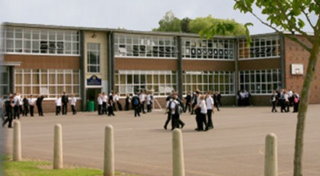
A school is an educational institution designed to provide learning spaces and learning environments for the teaching of students under the direction of teachers. Most countries have systems of formal education, which is sometimes compulsory. In these systems, students progress through a series of schools. The names for these schools vary by country but generally include primary school for young children and secondary school for teenagers who have completed primary education. An institution where higher education is taught, is commonly called a university college or university.

A boarding school is an institution where children live within premises while being given formal instruction. The word "boarding" is used in the sense of "room and board", i.e. lodging and meals. As they have existed for many centuries, and now extend across many countries, their function and ethos varies greatly. Children in boarding schools study and live during the school year with their fellow students and possibly teachers or administrators. Some boarding schools also have day students who attend the institution by day and return off-campus to their families in the evenings.
Education in the United States of America is provided in public, private, and home schools. State governments set overall educational standards, often mandate standardized tests for K–12 public school systems and supervise, usually through a board of regents, state colleges, and universities. The bulk of the $1.3 trillion in funding comes from state and local governments, with federal funding accounting for only about $200 billion. Private schools are generally free to determine their own curriculum and staffing policies, with voluntary accreditation available through independent regional accreditation authorities, although some state regulation can apply.

Gymnasium is a term in various European languages for a secondary school that prepares students for higher education at a university. It is comparable to the British English terms grammar school and sixth form college, and to US English preparatory high school. Before the 20th century, the gymnasium system was a widespread feature of educational systems throughout many European countries.
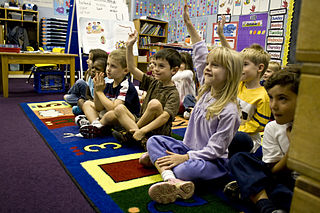
Kindergarten is a preschool educational approach based on playing, singing, practical activities such as drawing, and social interaction as part of the transition from home to school. Such institutions were originally made in the late 18th century in Bavaria and Alsace to serve children whose parents both worked outside home. The term was coined by the German Friedrich Fröbel, whose approach globally influenced early-years education. Today, the term is used in many countries to describe a variety of educational institutions and learning spaces for children ranging from 2 to 6 years of age, based on a variety of teaching methods.
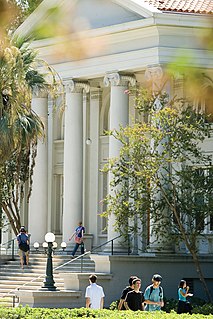
Undergraduate education is education conducted after secondary education and prior to postgraduate education. It typically includes all postsecondary programs up to the level of a bachelor's degree. For example, in the United States, an entry-level university student is known as an undergraduate, while students of higher degrees are known as graduate students. In some other educational systems, undergraduate education is postsecondary education up to the level of a master's degree; this is the case for some science courses in Britain and some medicine courses in Europe.

The education system in Finland consists of daycare programmes, a one-year "pre-school", and an 11-year compulsory basic comprehensive school. Nowadays secondary general academic and vocational education, higher education and adult education are compulsory.

In France, secondary education is in two stages:
State schools or public schools are generally primary or secondary schools that educate all children without charge. They are funded in whole or in part by taxation. State funded schools exist in virtually every country of the world, though there are significant variations in their structure and educational programmes. State education generally encompasses primary and secondary education.
The levels of Ireland's education are primary, secondary and higher education. In recent years further education has grown immensely. Growth in the economy since the 1960s has driven much of the change in the education system. For universities there are student service fees, which students are required to pay on registration, to cover examinations, insurance and registration costs.
Education in Vietnam is a state-run system of public and private education run by the Ministry of Education and Training. It is divided into five levels: preschool, primary school, secondary school, high school, and higher education. Formal education consists of twelve years of basic education. Basic education consists of five years of primary education, four years of secondary education, and three years of high school education. The majority of basic education students are enrolled on a daily basis. The main education goal in Vietnam is "improving people's general knowledge, training quality human resources, and nurturing and fostering talent."

The educational system in Taiwan is the responsibility of the Ministry of Education. The system produces pupils with some of the highest test scores in the world, especially in mathematics and science. Former president Ma Ying-jeou announced in January 2011 that the government would begin the phased implementation of a twelve-year compulsory education program by 2014.
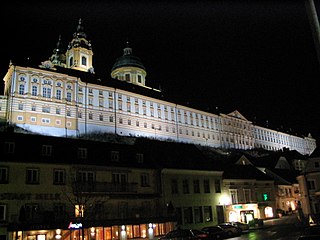
The Republic of Austria has a free and public school system, and nine years of education are mandatory. Schools offer a series of vocational-technical and university preparatory tracks involving one to four additional years of education beyond the minimum mandatory level. The legal basis for primary and secondary education in Austria is the School Act of 1962. But in 1963 it went back to the way it was. But again In 1999 it finally changed again. The federal Ministry of Education is responsible for funding and supervising primary, secondary, and, since 2000, also tertiary education. Primary and secondary education is administered on the state level by the authorities of the respective states.

Education in Hungary is predominantly public, run by the Ministry of Human Resources. Preschool kindergarten education is compulsory and provided for all children between three and six years old, after which school attendance is also compulsory until age of sixteen. Primary education usually lasts for eight years. Secondary education includes three traditional types of schools focused on different academic levels: the Gymnasium enrols the most gifted children and prepares students for university studies; the secondary vocational schools for intermediate students lasts four years and the technical school prepares pupils for vocational education and the world of work. The system is partly flexible and bridges exist, graduates from a vocational school can achieve a two years program to have access to vocational higher education for instance. The Trends in International Mathematics and Science Study (TIMSS) rated 13–14-year-old pupils in Hungary among the best in the world for maths and science.

Birzeit University is a public university in the West Bank, registered by the Ministry of Social Affairs as charitable organization. It is accredited by the Ministry of Higher Education and located in Birzeit, West Bank, near Ramallah. Established in 1924 as an Elementary School for girls, Birzeit became a University in 1975.
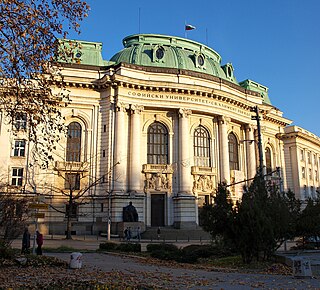
Education in Bulgaria is overseen by the Ministry of Education and Science. Since 2012, compulsory education includes two years of preschool education, before children start primary school. Education is compulsory until age of 16. Education at state-owned schools is free of charge, except for the higher education schools, colleges and universities.

The history of education in the United States, or Foundations of Education covers the trends in educational formal and informal learning in America from the 17th century to the early 21st century.

Education in Madagascar has a long and distinguished history. Formal schooling began with medieval Arab seafarers, who established a handful of Islamic primary schools (kuttabs) and developed a transcription of the Malagasy language using Arabic script, known as sorabe. These schools were short-lived, and formal education was only to return under the 19th-century Kingdom of Madagascar when the support of successive kings and queens produced the most developed public school system in precolonial Sub-Saharan Africa. However, formal schools were largely limited to the central highlands around the capital of Antananarivo and were frequented by children of the noble class andriana. Among other segments of the island's population, traditional education predominated through the early 20th century. This informal transmission of communal knowledge, skills and norms was oriented toward preparing children to take their place in a social hierarchy dominated by community elders and particularly the ancestors (razana), who were believed to oversee and influence events on earth.

The Haitian Educational System yields the lowest total rate in the education realm of the Western Hemisphere. Haiti's literacy rate of about 61% is below the 90% average literacy rate for Latin American and Caribbean countries. The country faces shortages in educational supplies and qualified teachers. The rural population is less educated than the urban. The 2010 Haiti earthquake exacerbated the already constrained parameters on Haiti's educational system by destroying infrastructure and displacing 50–90% of the students, depending on locale.















